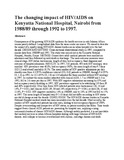| dc.description.abstract | Consequences of the growing HIV/AIDS epidemic for health services in sub-Saharan Africa remain poorly defined. Longitudinal data from the same centre are scarce. We aimed to describe the impact of a rapidly rising HIV/AIDS disease burden on an urban hospital over the last decade.
DESIGN AND SETTING:
Cross-sectional observational study in 1997, compared to similar data from 1988/89 and 1992. The study was carried out in the Kenyatta National Hospital, Nairobi, Kenya.
METHOD:
Consecutive adult medical patients were enrolled on admission and then followed up until death or discharge. The main outcome measures were clinical stage, HIV status, bacteraemia, length of stay, bed occupancy, final diagnosis and outcome of hospital admission.
RESULTS:
In 1997, 518 patients, 493 with HIV serology, were enrolled: HIV prevalence was 40.0%, bed occupancy 190%, the mean length of stay 9.5 days (SD 12) and overall mortality 18.5%. The mean number of HIV-positive admissions per day steadily rose from 4.3 [95% confidence interval (CI), 0.6] patients in 1988/89, through 9.6 (95% CI, 1.4) in 1992, to 13.1 (95% CI, 2.8) or 13.9 adjusted for those enrolled without HIV serology in 1997. In contrast the mean number admitted with clinical AIDS, 1.7 in 1988/89 and 3.3 in 1992, fell to 2.6 cases per day in 1997. With HIV-negative admissions increasing by 37% and bed occupancy nearly doubling in 1997, HIV prevalence appeared to be stabilizing (19 then 39 and 40% respectively). Over time fewer HIV-infected patients were bacteraemic (26, 24 and 14%; P < 0.01); had clinical AIDS (39, 34 and 24% respectively; P < 0.01); or died (36, 35 and 22.6%; P < 0.02). HIV-negative mortality, 14% in 1988/89, rose to 23% in 1992 but fell to 15% in 1997. The mean length of hospital stay (9.5-10 days) did not differ according to HIV status nor did it change across the decade.
CONCLUSION:
The HIV/AIDS disease burden in Kenyatta National Hospital medical wards has risen inexorably over the last decade. Most recently, the number of HIV-uninfected patients has also risen, leading to bed occupancy figures of 190%. Despite overcrowding and irrespective of HIV status, in-patient mortality has fallen. Time trends suggest fewer clinical AIDS patients are presenting for hospital care, implying a rising community burden of chronic HIV/AIDS disease. Although widely predicted, it is not inevitable that medical services in urban African hospitals dealing with large volumes of HIV/AIDS disease, will collapse or become overwhelmed with chronic, end-stage disease and death. | en |

